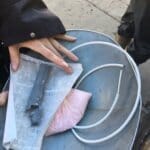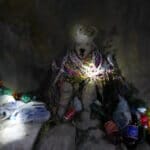I am a firm believer that you cannot truly understand your chosen destinations until you experience both sides. While many people only ever see the glossy touristic exterior of a country or city, to understand the full story sometimes you need to delve a little deeper and, sometimes unearth pain and mortality.
Cerro Rico (Rich Mountain) in the world’s highest city, Potosí in Bolivia is one such “attraction”. Still in operation since silver was first discovered here, the mountain that symbolises the city still claims lives to this day. Once the Spanish arrived in Potosí it didn’t take them long to start extracting the silver from the mountain and Potosí was soon the richest city in the world, the largest city in Latin America and Cerro Rico the worlds largest mine throughout the seventeenth century.
The number of active mines in the mountain is now is only a handful compared to the height of its popularity, but every day men and children don hard hats and dirtied work jackets to descend into the bowels of the earth, praying that they will make it through the day to see their loved ones again for only a few dollars for their hours of back breaking work.
Geologists estimate that there is still as much silver left in the mine as has been extracted over the last few hundred years but it is now buried so deep that it is becoming too dangerous and too costly to extract but the Potosí of today is a far cry from its heyday in Spanish Colonial times and there is precious little other than tourism for the locals to turn to so they still, reluctantly, look to the mine.
3 of the surviving mines have been classed as safe enough for tourists to view for themselves but while the conditions in these mines are some of the best in the mountain they really do give you a good sense of the harsh daily life the men and children of this city must endure just to put food on the table for their families.
Tours of the mines are offered daily and are run by ex miners that have survived a life of seriously hard labour. While conditions in the public mines have been improved a little, the conditions in the mountain still shock in their almost primitive form.
Looking up at the mountain from our hotel anyone would think the place was largely deserted but after crossing the security checkpoint and starting our climb it was clear that there is a thriving community living as well as working on the mountain. They live here not through choice but because they cannot afford a house in town or further out, their lives inextricably linked to the mountain they must also call home.
It is estimated that the mountain still contains enough silver to continue mining for roughly another generation, or about 80 years but once it becomes financially cost prohibitive what will happen to these nomadic dwellers who depend on the mountain as their only source of income either directly or indirectly through running tours or selling small souvenirs to the visiting tourists? Nobody has really thought that far ahead.
There is also a thriving secondary market linked to the mining activity in a small market at the base that operates solely for the sale of goods for the miners and mine related equipment. What will happen to the livelihoods of these people that also depend on the mine and steady flow of tourist dollars that come their way?
The miners are deeply religious and multiple daily offerings are made to the god of the mine, El Tío, whose physical manifestation is a statue that is a focus of prayer and gifts. Keep El Tío happy and he will look after you in the mountain.
While not compulsory, tourists visit the market first to purchase offerings such as cigarettes, alcohol and cocoa leaves as offerings to El Tío. Bottles of water, cigarettes and cocoa leaves are also popular to give to the miners as small tokens of your appreciation. The market also sells sticks of nitroglycerin aka dynamite to the miners for as little as 80p a pop but good luck getting that through customs on the way home.

A stick of dynamite is easy to come by in the market before you descend into the mountain but is only available for miners to purchase.
Grabbing a makeshift handrail the uneven steps down to a subsidiary shaft were a surprise to us all. The walls were narrow and the ceiling so low in parts we had no choice but to slide down on our bums.
Turning a corner the outside light vanished. From here on in we would have to trust our not too powerful headlamps. Descending still further into an unknown world we could hear drilling far in the distance.
The mine is a maze of seemingly identical tunnels held up perilously with small trunks of wood at irregular intervals. There are no lights or signs, the miners know the layout by memory. If there is a problem down here there is no escape.
Should the miners survive poisonous gasses, explosions and cave ins, the mountains current state more resembles swiss cheese after centuries of mining have left the mountain peak in risk of collapse thanks to a 700 meter sinkhole that opened up in 2011. Its the largest but far from the only one in the mountain that now threatens its very stability. In 2014 UNESCO put the mountain on it’s list of endangered sites because of the uncontrolled mining that threatens the future stability of the mountain.
Potosí has no industries of its own and roughly 15% of the male population of the city still work in the mines as part of a miners collective. That means they own a stake in the mine in which they work and share in its successes and failures. Tourism plays a small part but most of their livelihood still rely on mining the remaining silver that was once the worlds largest single deposit.
The average life expectancy of a miner is just 40 years thanks to the gasses and dust they breathe in for up to 12 hours a day to support their families not to mention extreme exhaustion and accidents with dynamite and mine collapses. While we are taken round on our short 3 hour tour we see numerous men hammering away in solitude with just their headlamps or moving ore from one spot to another. They will have no other human contact until they leave the mine at the end of their shift. The days are long, arduous, hot and dangerous but you won’t once see these men complaining.
None of the tour operators condone the working conditions in the mine yet there appears to be precious little being done to improve them for the remaining workers. Nobody will argue that what you will see in the mountain is not treacherous but the mountain and the riches it contains will forever be a part of this city. By taking a tour of the mines you are contributing a small bit to the community while getting a greater understanding of the hardships the people have to endure to survive.

Inside Cerro Rico the silver rich veins are now buried deep in the mountain. Different layers are accessible only by make shift ladders.
The misery that is Cerro Rico’s legacy for the men of Potosí has made it perhaps Bolivia’s most important national monument. It is estimated that over 8 million men have died in the mountain earning the mountain it’s other nickname, the “Mountain That Eats Men”. It was added to UNESCO’s World Heritage List in 1987.
Long after the last remnants of silver have been extracted, Cerro Rico’s legacy will live on through the tourism it brings to the city but at what cost to the population?
 Copyright secured by Digiprove © 2017
Copyright secured by Digiprove © 2017








